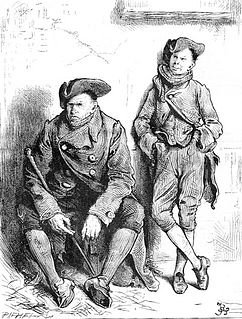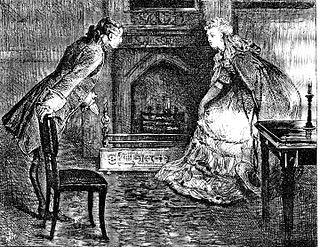External links
| This article about a fictional character from a novel is a stub. You can help Wikipedia by expanding it. See guidelines for writing about novels. Further suggestions might be found on the article's talk page. |
Ernest Defarge is a fictional character in Charles Dickens' 1859 novel, A Tale of Two Cities .
Defarge is the owner of a wine shop in the slum of Saint Antoine in Paris. He and his wife Madame Therese Defarge are passionate advocates for revolution and regularly dispense and gather information from inside the wine shop. When the story starts, Defarge is harboring Dr. Alexandre Manette, his old employer, who has just been released from eighteen years of unjust and secret imprisonment in the Bastille. Defarge is incredibly loyal to Dr. Manette and truly cares for him, but he doesn’t shrink from a little exploitation by showing Manette to other patriots as an inspiration for the revolt he hopes to incite. Defarge tells Manette’s story to a group of men in the hopes that they will spread the word of yet another injustice perpetrated by the aristocracy - specifically, a notorious pair of brothers named St. Evrèmonde. Defarge is the leader of his community and will be pivotal in leading the people on the Storming of the Bastille. He discovers a paper in Dr. Manette’s old cell in the Bastille which documents why Manette was imprisoned and by whom. These papers prove nearly fatal to the novel's protagonist, Charles Darnay, in recounting a series of injustices and murders by his father and uncle. Worse still, these infamies were committed against the family of Madame Defarge, Ernest's ruthless wife, who convinces him to denounce Darnay to the guillotine. Generally good-natured and decent, Defarge is torn by loyalty to his wife and loyalty to Dr. Manette; he does nothing to stop Manette's family from escaping France, despite Madame Defarge's urging. Darnay is not executed however; he is saved by Carton. Carton prophesies that Ernest Defarge and the Vengeance will be consumed by the Revolution's guillotine.
In the 1935 Metro-Goldwyn-Mayer film adaptation, Ernest Defarge is portrayed by Mitchell Lewis.
In the 2008 Broadway adaptation of 'A Tale of Two Cities,' Ernest Defarge is played by Kevin Earley.
| This article about a fictional character from a novel is a stub. You can help Wikipedia by expanding it. See guidelines for writing about novels. Further suggestions might be found on the article's talk page. |
A Tale of Two Cities is a 1935 film based upon Charles Dickens' 1859 historical novel, A Tale of Two Cities, set in London and Paris. The film stars Ronald Colman as Sydney Carton, Donald Woods and Elizabeth Allan. The supporting players include Reginald Owen, Basil Rathbone, Claude Gillingwater, Edna May Oliver and Blanche Yurka. It was directed by Jack Conway from a screenplay by W. P. Lipscomb and S. N. Behrman. The film was nominated for the Academy Award for Best Picture and Best Film Editing. The story is set in France and England and spans several years before and during the French Revolution. It deals with the evils that precipitated the Revolution and with an innocent family and their friends caught up in the horrors of the Terror. Charles Darnay, a French aristocrat who has rejected his rank and moved to England, and Sidney Carton, a perpetually intoxicated English advocate, both fall in love at first sight of Lucie Manette. Lucie has brought her father to England to recover from years of unjust imprisonment in France. She marries Darnay and they befriend Carton. In the end, Carton saves Darnay's life by taking his place at the guillotine. The film is generally regarded as the best cinematic version of Dickens' novel and the best performance in Colman's career.

Lucie Manette is a character in Charles Dickens' 1859 novel A Tale of Two Cities.

Madame Thérèse Defarge is a fictional character in the 1859 novel A Tale of Two Cities by Charles Dickens. She is a ringleader of the tricoteuses, a tireless worker for the French Revolution, and the wife of Ernest Defarge.
Doctor Alexandre Manette is a character in Charles Dickens' 1859 novel A Tale of Two Cities. He is Lucie's father, a brilliant physician, and spent eighteen years "in secret" as a prisoner in the Bastille prior to the French Revolution. He is imprisoned because in the course of his medical practice he learns of abusive actions by two members of the aristocratic Evrémonde family. While realizing the power at court of nobles such as the Evrémondes, Manette reports them to a minister of the royal government. He is seized from his young family and imprisoned under a lettre de cachet.

Sydney Carton is a central character in Charles Dickens' 1859 novel A Tale of Two Cities. He is a shrewd young Englishman educated at Shrewsbury School, and sometime junior to his fellow barrister Stryver. Carton is portrayed as a brilliant but depressed and cynical drunkard who is full of self-loathing because of what he sees as his wasted life. He feels a deep unrequited love for Lucie Manette, who nevertheless inspires him to try to be a better person. Near the end of the novel, Carton manages to change places with her husband Charles Darnay hours before Darnay's scheduled execution in France, giving his life for Lucie's sake. Later, Lucie and Charles name their first son after Carton.

Charles Darnay, Charles D'Aulnais or Charles St. Evrémonde is a fictional character in the 1859 novel A Tale of Two Cities by Charles Dickens.

A Tale of Two Cities is an 1859 historical novel by Charles Dickens, set in London and Paris before and during the French Revolution. The novel tells the story of the French Doctor Manette, his 18-year-long imprisonment in the Bastille in Paris and his release to live in London with his daughter Lucie, whom he had never met. The story is set against the conditions that led up to the French Revolution and the Reign of Terror.

A Tale of Two Cities is a 1958 British film directed by Ralph Thomas and starring Dirk Bogarde and Dorothy Tutin. It is a period drama based on parts of Charles Dickens' novel A Tale of Two Cities (1859).

The seamstress is a fictional character in Charles Dickens's 1859 novel A Tale of Two Cities.

The Marquis St. Evrémonde is a fictional character in Charles Dickens' 1859 novel A Tale of Two Cities.

A Tale of Two Cities is a musical with book, music and lyrics by Jill Santoriello based on the 1859 novel of the same name by Charles Dickens.

Jeremiah "Jerry" Cruncher is a fictional character in Charles Dickens' 1859 novel A Tale of Two Cities.
John Barsad is a character in Charles Dickens' 1859 novel, A Tale of Two Cities.

Jarvis Lorry is a character in Charles Dickens' 1859 novel, A Tale of Two Cities.

Miss Pross is a character in Charles Dickens' 1859 novel, A Tale of Two Cities.

Stryver is a character in Charles Dickens's 1859 novel A Tale of Two Cities and in the 10 TV/film adaptations of the story. He is a barrister in London, with the character Sydney Carton working under him.

The Only Way is a 1926 British drama film directed by Herbert Wilcox and starring John Martin Harvey, Madge Stuart and Betty Faire. It was adapted from the play The Only Way which was itself based on the 1859 novel A Tale of Two Cities by Charles Dickens. John Martin Harvey had been playing Carton in the play since 1899 and it was his most popular work. It cost £24,000 to make and was shot at Twickenham Studios. The film was a commercial success and reportedly took over £53,000 in its first two years on release. It was a particularly notable achievement given the collapse in British film production between the Slump of 1924 and the passage of the Cinematograph Films Act 1927 designed to support British film making.
Dicky Monteith is a 1922 British silent drama film directed by Kenelm Foss and starring Stewart Rome, Joan Morgan and Jack Minister. Its plot involves a lawyer who tries to con a drunken client out of a large sum of money. It is an adaptation of a play by Tom Gallon and Leon M. Lion.

A Tale of Two Cities is a 1980 American historical and drama film made for TV, directed by Jim Goddard and starring Chris Sarandon, who plays dual roles as two characters who are in love with the same woman. It is based on the 1859 Charles Dickens novel of the same name set in the French Revolution.

A Tale of Two Cities is a 1917 American silent historical drama film directed by Frank Lloyd and starring William Farnum, Jewel Carmen, and Charles Clary. The film is based on Charles Dickens' 1859 novel of the same name, which has been filmed a number of times.